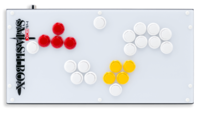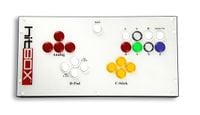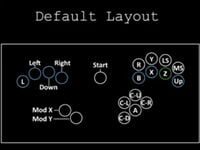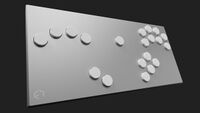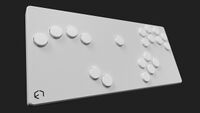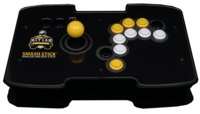Arcade controller: Difference between revisions
(→Smash Stick: lol) Tag: Mobile edit |
(Many people like to call them rectangles to differentiate them from boxes) |
||
| Line 1: | Line 1: | ||
[[File:KazuyaSmashBox.gif|thumb|250px|Kazuya executing perfect [[Crouch Dash]]es with the SmashBox.]] | [[File:KazuyaSmashBox.gif|thumb|250px|Kazuya executing perfect [[Crouch Dash]]es with the SmashBox.]] | ||
An '''arcade controller''' — sometimes referred to as a '''fightstick''' | An '''arcade controller''' — sometimes referred to as a '''fightstick''', '''box controller''', or '''rectangle''' — is a controller designed after an arcade cabinet's control deck, mainly designed for use with traditional fighting games. The rise of modern arcade controllers dates back to 1987 with the release of the original ''Street Fighter'' and has since been a staple in the fighting game community. | ||
Due to the relative creative freedom alloted to arcade cabinet developers on how a game should be controlled, there is no constitution that defines what an arcade controller is supposed to look like. That being said, the most common and traditional design aspects are a large joystick and ergonomically-aligned buttons, as well as a "box" base to place on a player's lap or other flat surface. | Due to the relative creative freedom alloted to arcade cabinet developers on how a game should be controlled, there is no constitution that defines what an arcade controller is supposed to look like. That being said, the most common and traditional design aspects are a large joystick and ergonomically-aligned buttons, as well as a "box" base to place on a player's lap or other flat surface. | ||
Revision as of 15:39, July 18, 2024
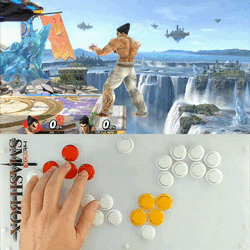
An arcade controller — sometimes referred to as a fightstick, box controller, or rectangle — is a controller designed after an arcade cabinet's control deck, mainly designed for use with traditional fighting games. The rise of modern arcade controllers dates back to 1987 with the release of the original Street Fighter and has since been a staple in the fighting game community.
Due to the relative creative freedom alloted to arcade cabinet developers on how a game should be controlled, there is no constitution that defines what an arcade controller is supposed to look like. That being said, the most common and traditional design aspects are a large joystick and ergonomically-aligned buttons, as well as a "box" base to place on a player's lap or other flat surface.
Nintendo has created an arcade controller titled the NES Advantage in 1987 for the Nintendo Entertainment System, which enlarges the button and uses a joystick in place of a D-pad, and is primarily meant for home console ports of arcade games. ASCII Corporation would follow this up with the Super Advantage in 1992 for the Super Entertainment System and made mostly the same changes. Hori developed the Wii Fighting Stick and peripheral developer MadCatz partnered with Capcom to develop an arcade controller to coincide with the game Tatsunoko vs. Capcom: Ultimate All-Stars. Hori returned alongside Bandai Namco to release a Wii U arcade controller to coincide with Tekken Tag Tournament 2: Wii U Edition. Several manufacturers, including Hori and PowerA, have developed arcade controllers specifically for Nintendo Switch.
Compatibility
Any arcade controller can be used for any hardware it can connect to and is compatible with. This sometimes creates an issue where arcade controllers meant to be used on a specific proprietary system are effectively locked to said system and are not forwards compatible with new hardware. Also, a new developmental hurdle arcade controller users and manufacturers face is the introduction of firmware updates that can suddenly make previously compatible controllers incompatible, sometimes meant specifically so, necessitating firmware updates of its own.
Despite the growing compatibility and options, no game in the Smash franchise officially supports arcade controllers as an option and thus does not automatically map buttons accordingly. However, all arcade controllers with internal components based on official controllers licensed by Nintendo are unofficially compatible with the Smash series, albeit with the player having to manually configure the button layout.
Advantages
Arcade controllers are noticeably more durable than the average controller thanks to their size and materials. This makes them suitable for transport, as their size also makes them much harder to lose than a regular controller. The inherent customizable nature of arcade controllers allows each individual player to create their ideal experience with minimal effort and expertise, with players often purchasing custom faceplates. Arcade controllers have also been praised for making advanced techniques easier, as well as increasing the viability of execution-reliant characters like Terry,[1] resulting in increased metagame diversity. These button layouts — particularly the "home" layout — have also garnered praise for lessening stress on player's hands, allowing those with repetitive strain injury-related conditions such as carpal tunnel to compete with minimal hand pain. Generally, arcade controllers are praised for increasing Smash's accessibility.
Disadvantages
Due to their drastically different control layouts, arcade controllers are often considered to have higher learning curves compared to the average controller, making them harder to switch to from traditional ones. The considerable increase in surface area means that the player needs to put more effort into performing an input than a controller user doing the same. This leads to artificially slower reaction times for inexperienced users of arcade controllers, though this downside wanes with time. Arcade controllers also tend to be much more expensive than regular controllers, and the world of used arcade controllers is almost nonexistent due to the occasionally mandatory purchasing of new components, effectively making it new again and no guarantee that it will be compatible with the system, a risk regular controllers do not experience. Arcade controllers with buttons in place of a stick also contain the same shortcoming as keyboards in that the subtle input reading of a stick is removed and a player can only be stopped or moving at one speed as well as lose access to specific angles that hamper recoveries without mapping each movement speed and angle to an individual button, making the controller far more complicated to use than a standard controller.
Smash Box
The Smash Box is a controller designed by Hit Box founder Dustin Huffer. The design of the controller is reminiscent of a traditional arcade controller used by other fighting games, with one notable exception: the lack of a joystick. In an attempt to address precision and health issues associated with the joystick, the Smash Box instead uses analog buttons, a significant difference compared to other arcade controllers, but also one that has paved the way for more like it. Like many quality arcade controllers, it uses 24mm Sanwa Denshi OBSF-24 buttons.
The Smash Box has many quality of life features, including button remapping, control profiles for easy switching between games, and compatibility with the GameCube, Wii, Wii U, Switch, and PC. It can also use the Wii Nunchuk for analog control. It comes with built-in Super Smash Bros. Ultimate, Super Smash Bros. Melee, and Rivals of Aether controller profiles. The precision of its button remapping has garnered criticism from players for being arguably better than the standard GameCube controller, bringing questions of tournament balance into the equation.
The Smash Box received notable praise and financial backing,[2] but ran into controversy over its tournament legality; several smashers accused the controller of potentially providing an unfair advantage for those who were able to use it. As a result of this uncertainty, GENESIS 4 permitted players to use the Smash Box controller in an attempt to test the controller.[3] EVO 2018 also permitted the Smash Box's use, and it continues to see tournament play on all levels.
Controversy
In 2017, Hax$ assisted Hit Box during the development of the Smash Box, but found its button placement to be unsatisfactory. After his requests for better button placement and payment for his analysis were refused, he parted ways with the company and went on to produce the B0XX, which has improved alignments and modifications to make it more tournament viable. Hax$ released a video on the topic accusing Hit Box of stealing his design and explaining the benefits to his B0XX controller over the Smash Box.[4]
Gravy would contest these claims and argued that Hax$ "acted as an authoritarian lead designer throughout the time he spent playtesting", producing a video on the topic. In this video, Gravy shows that the button layout the B0XX used was the one that he and Hax$ discussed prior, and claims Hax$ used this layout to compete with the Smash Box and say that it has an inferior layout, arguing that the B0XX's layout was a stolen design. Gravy also contradicts Hax$'s claim that he didn't want a straight button layout, as his main layout contributions used straight layouts. He also contested Hax$'s insistence on removing the X button, arguing that two jump buttons is important for these types of controllers to ensure that all advanced techniques have accessible routes. Gravy believes Hax$ sabotaged the Smash Box to try and get the Kickstarter to fail. Gravy also acknowledges the claim that he said he wanted to fight Hax$ and apologises for those words.
tompas92 also accused Hax$ of deliberately abstaining from conversations about legality with the intention of getting the controller banned later.[5] This was after working with Hax$ on the B0XX, where he claimed to have been treated negligently.
B0XX
The B0XX is an alternative to the Smash Box designed for those who suffer with carpal tunnel syndrome or other hand problems, produced by Hax$. The name is a play on the 20XX meme. Similar to the Smash Box, it forgos an arcade stick in favour of using Sanwa arcade buttons, but is deliberately balanced for the purposes of being legal in competitive Melee and Ultimate tournaments.[6] The B0XX aims to be as ergonomically optimised as possible while remaining efficient. Rather than surpass the GameCube controller, it aims to coexist with it and simply exist as an alternative. The B0XX has no need for a GameCube controller adapter to connect to a PC, instead utilising USB-C. It also has USB-C to GameCube functionality, as well as compatibility with the Wii Nunchuck. Mod buttons are put in place as a kind of "shift key", allowing for the controller to still replicate GameCube controller functions.
Balancing measures
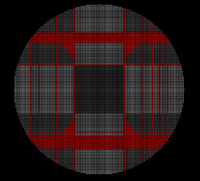
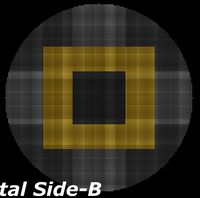
Due to the precision necessary to consistently pinpoint some angles on the GameCube controller's analog stick, the B0XX makes them inaccessible. Many of these values are extremely thin and cannot be found on control stick notches, making the input requirements almost impossible for humans. The "bans" on these values result in multiple intentional nerfs intended to maintain realism on the B0XX's control scheme, ensuring it isn't outclassing the standard GameCube controller and remains in line with competitive specifications. In competitive play, in part thanks to the balancing measures put in place, the B0XX has been approved for use in various tournaments, such as GENESIS, The Big House, Super Smash Con, and Shine.
The B0XX notably assists Fire Fox and extended up special angles, assisting characters like Fox, Falco, and Sheik.[9] However, it is also impossible to use difficult-to-access desyncs, shield drop directly downwards, or use extremely light or heavy inputs, balancing measures deliberately put in place by Hax$. This has garnered praise from the Melee community and largely appeased critics.
The "banned" coordinates include;
- Y-Tilt + > 50°, preventing;
- The use of unbuffered turnaround up or down tilt attacks.
- Leaving the ledge without fast falling while allowing a ledgedash.
- Y-Tilt + up special, preventing;
- Use of up special without tap jumping.
- Using moves such as Shine without dropping through a platform.
- Shield drop down
- This prevents shield dropping without shutting out the ability to roll by mistake; this was banned due to Melee standardising the notch shield drop method in competitive play via UCF.
- Short hop tap jump
- Jigglypuff, Kirby, and Yoshi's ability to double jump without turning around.
- Pikachu's double up special.
- Middle angled forward and forward smash angles, making only the default angles possible.
- These are borderline unused angle values, remnants of additional angles for forward tilt and smashes; these only have singular values in the final game, making them almost unseen.
- Ice Climber desync points
- There are occasions where Nana's control stick Y-values will be 1 off from Popo's, allowing for solo smash attacks, tap jumps, and more. This removes them.
- Airdodge and Fire Fox angles are limited, balanced around a notchless GameCube controller, factoring in that not all players have them.
- Fire Fox has 11 angles per quadrant, allowing for a well-rounded selection of angles without allowing for anything unfeasible to land in a tournament setting. Similar, but more complex measures are put in place for characters like Sheik's extended up special angles as well, ensuring the B0XX remains viable for those characters.
Some input sequences also have frame lockouts to be in line with a conventional notchless GameCube controller;
- Double-Quarter Circle SDI has a 4 frame lockout, preventing impossible input sequences.
- Pivot up tilt inputs have a 9 frame lockout.
- Pivot down tilt inputs have a 4 frame lockout.
Controversy
Royal Flush would invite Hax$ to compete using the B0XX, but Leffen would protest its use on the grounds of being a "modded controller", in which Royal Flush rescinded the invite. Hax$ would still attend the event to meet friends, where he would find out WatchingTime arranged to give Leffen a prototype arduino as part of a project to assist with legalising the B0XX for competitive play. Hax$ shook WatchingTime's shoulder in a panic and demanded for it to be returned to him. Leffen would find out about this and ask for the arduino, and Hax$ would decline before approaching Leffen with accusations of malfeasance. Upon the B0XX's official release, Leffen claimed there is no evidence of keyboard-style arcade controllers being better ergonomically, as well as cause to believe the B0XX could abuse cardinal 1.0, which Hax$ refuted.
As part of his "evidence.zip 2" video, Hax$ revealed information on Leffen's role in its development. Hax$ accused Leffen of unfair bias against the B0XX, claiming that he engaged in a disinformation campaign aimed at hurting the controller's community and trying to unjustly ban the controller. Hax$ cited various YouTube videos where Leffen makes false claims, such as a notion that using the L button to L-cancel is optimal over the Z button, whereas Hax$ argues that it's blatantly false and the Z button not locking the player out of tech during hitlag makes it superior. Leffen also made a unique button layout for the B0XX with his L-cancel preferences implemented among other perceived enhancements, which Hax$ also criticises as unergonomic and compares to "deleting System32" and that his "narcissism" made him find problems that didn't exist. Moderators from Hax$'s B0XX Discord server would attempt to argue their case with Leffen, though little would come of this. Pipsqueak would corroborate Leffen's opinion, in which Hax$ insulted them, calling them "Leffen's bitch", wherein Hax$ would receive criticism. Hax$ responded with an apology for his unprofessionalism in the "button swap debate",[10] which he later recanted in June as "damage control", and believes he did nothing wrong. Leffen responded to the video by expressing interest in contacting a lawyer,[11] due to the other claims in the evidence.zip 2 video. These claims were repeated in a follow-up video dubbed "evidence.zip 3". On the 24th of September 2021, Hax$ released a video apologising for his handling of the overall situation.[12]
Frame1
The Frame1 is an arcade controller produced by former B0XX developer Greg Turbo, revealed in September 2020. An Open Source repository called Open-Frame1 is available, allowing one to produce a Frame1 Light PCB, in part due to supply issues.
Originally a concept that was produced in 2017 with a cardboard box, this would lead to Greg Turbo assisting with the B0XX's development before leaving the team. The Frame1 prioritises latency, using a strong processor to make it faster than most controllers. It also uses a thin "box" for lightweight portability, as well as a non-slip design so it's easier to stay on one's lap. Unlike its competitors, the Frame1 uses optical Gateron buttons — the first of its kind to do so — giving it some additional longevity. The controller first opened for pre-order September 11, 2020.
The Frame1 is compatible with the GameCube, Wii, Switch, and PC, but a brook board can allow it to be used with the Xbox One and PS4 as well.
On July 6th, 2021, Frame 1 sponsored yingling.[13]
Smash Stick
The Smash Stick is an upcoming "fightstick" produced by Alt Lab Controllers. Beta production was announced in 2021, but as of June 2024, the website and Twitter pages have not been updated.
The Smash Stick uses a traditional arcade controller layout, joystick, and 24mm Sanwa buttons, making it the only Smash-centric arcade controller to use a joystick. It features a swappable octagon gate with the joystick, allowing customization with other gates like square, circle and hexagon. The artwork can also be customised by removing the acrylic panel. Like other arcade controllers, it's designed with the intention of reducing hand strain. Additionally, it's compatible with all Smash titles,[14] being usable on the N64, GameCube, Wii, Wii U, Switch, and more. The Smash Stick was successfully funded via Kickstarter.[15]
The Smash Stick features notches designed to make shield dropping in Melee easier without the need for mods, and the joystick is also designed to do all analog inputs a normal control stick can perform. It also uses non-contact sensors to prevent wear and tear from hurting the controller's performance over time. It uses a "home layout" for its buttons along with some raised buttons, meaning little hand movement is necessary to play optimally. It also features full button remapping, with 9 profiles available.
The Smash Stick complies with Smash World Tour rules, making it legal in most tournaments.
Video
In competitive play
Arcade controllers are a relatively new discussion in the competitive Smash scene. This is due to other options like the GameCube controller being considered the gold standard for tournaments for many years and compatible arcade controllers being a rarity with few companies making a dedicated effort to make products for Nintendo consoles. This started to change when third party alternatives started to catch up in quality with official controllers and adaptive technology started advancing enough to make controllers work with otherwise incompatible systems. Also around this time, several well known Smash players developed permanent injuries or had conditions that degenerated their motor functions, forcing them to look for other solutions to keep playing. Arcade controllers were one of these solutions, and positive word of mouth allowed companies to invest more into the scene with controllers made specifically for Smash. Arcade controllers continue to gradually grow in popularity to this day, with the true peak of dedicated players yet to be seen.
Legality
The legality of arcade controllers is a controversial subject. Some argue that the controller's capacity to do otherwise impossible techniques, such as multiple simultaneous actions and performing complicated actions with greater ease, gives users an unfair advantage over regular controllers. Some players within and outside the Smash community have gone as far as to consider these types of controllers cheating and advocate for their banning. Others argue that their inherent downsides, such as steep learning curves and loss of subtle intricacies regular controllers possess that lead to more limited and predictable gameplay, offset their advantages. Players for arcade controllers also cite the accessibility enhancements for those with hand problems, which has allowed many ex-competitors to return to tournaments. Hax$, one of the biggest proponents of these types of controllers, has gone as far as to nerf his B0XX controller for the sake of making it tournament-viable, largely appeasing community members. Outside of the Smash tournament scene, some controllers have explicitly been banned, with that ruling sometimes bleeding over into Smash tournaments. A notable example is the "GafroBox" that was popularized by Street Fighter player Daigo Umehara. On top of the already controversial Hitbox layout, this controller has a unique simultaneous opposing cardinal directions (abbreviated as SOCD) cleaner, meant to algorithmically decide which directional input would take priority over others held down at the same time, that prioritizes the latest input. The previous standard was to return the character to a neutral position. This change alters how games not designed for it are played, such as walking forward while charging inputs and allowing frame-perfect reaction times not possible on other controllers, and thus it was officially banned in all Capcom sanctioned tournaments.[16]
Arcade controllers are generally considered legal for tournaments given they comply with the same stipulations as all other controllers, specifically not including macros or turbo functionality or having specific firmware that alters how the game or characters are played.[17] However, this standard is not universal, and specific rulings are sometimes made on a case-by-case basis by tournament organizers with each individual arcade controller being inspected prior to a game to make sure no player is trying to smuggle unauthorized controllers into a tournament with malicious intent.
Trivia
- Hax$ once made a joke about Captain Falcon's optimal strategy being "L R A Start Fox" (quitting out of the game and selecting Fox), to the point he made a joke design for the B0XX with only those buttons being available.
References
- ^ https://www.hitboxarcade.com/blogs/smash-box/terry-overview-on-smash-box
- ^ [1]
- ^ [2]
- ^ https://www.youtube.com/watch?v=wAfLlDFp-Cg
- ^ https://www.dbltap.com/posts/4742326-smash-box-s-recent-struggle-and-the-questionable-origins-of-the-b0xx
- ^ The B0XX Manifesto
- ^ https://www.youtube.com/watch?v=uTYSgyca8cI
- ^ https://www.youtube.com/watch?v=uTYSgyca8cI
- ^ B0XX User Manual for Melee
- ^ [3]
- ^ https://twitter.com/TSM_Leffen/status/1401031413143642112
- ^ Apology video
- ^ [4]
- ^ Smash Stick Trailer
- ^ [5]
- ^ The GafroBox: The banned tech that made Daigo ditch his arcade stick
- ^ Smash World Tour ruleset, pg. 19
External links
- An interview with Dustin Hoffer about the Smash Box.
- The Kickstarter page for the Smash Box, along with descriptions about the controller and its development history.
- The B0XX Manifesto, which was used to assist in legalising the controller.
- News article on the Smash Stick.
- Frame1 review
- B0XX review
- Smash Stick review
- Smash Box review
| Controllers and buttons | |
|---|---|
| Nintendo 64 controller | |
| GameCube controller | |
| Wii Remote (and Nunchuk) | |
| Classic Controller | L |
| Nintendo 3DS | |
| Wii U GamePad / Pro Controller | L |
| Joy-Con | |
| Switch Pro Controller | L |
| Third-party controllers | Hori Mini Pad · Arcade controller · Keyboard |
| Other | Smash Controller · Controller modification |
